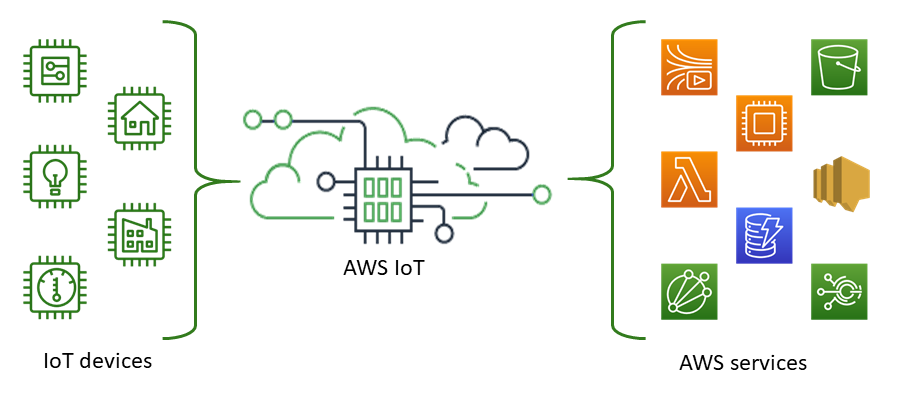Last updated on June 23, 2023
AWS IoT (Internet of Things) Core
- It is a managed cloud service that connects IoT devices to other devices and AWS cloud services easily.
- It can support billions of devices and routes trillions of messages to AWS services without managing an infrastructure securely and reliably.
- It offers connectivity between devices and the AWS cloud, continuous processing of data sent from connected devices and application interaction with connected devices.
- It supports the following protocol to help you manage and support your IoT devices
-
- MQTT (Message Queuing and Telemetry Transport)
- MQTT over WSS (WebSockets Secure)
- HTTPS (Hypertext Transfer Protocol – Secure)
- LoRaWAN (Long Range Wide Area Network)
-
Key Features
AWS IoT Device SDK
- allows you to easily and quickly connect your hardware device or mobile application to AWS IoT Core
- helps your devices connect, authenticate, and exchange messages with AWS IoT Core using the MQTT, HTTP, or WebSockets protocols
Device Advisor
- is a fully managed cloud-based test capability for validating IoT devices during development.
- provides pre-built tests that help developers validate their IoT devices
Device Gateway
- forms the pillar of communication between connected devices and cloud capabilities
- supports Publish and Subscribe Pub/Sub) messaging pattern over secure MQTT and WebSockets protocols, and publish over HTTPS protocol
Message Broker
- a high throughput Pub/Sub messaging agent that securely transmits messages to and from all of your IoT devices and applications
- supports messaging patterns ranging from one-to-one command and control messaging to one-to-one million (or more) broadcast notification systems
Authentication and authorization
- provides mutual authentication and encryption at all points of connections
- AWS IoT Core supports the AWS method of authentication (called SigV4), X.509 certificate-based authentication, and customer-created token-based authentication (through custom authorizers.)
-
-
- connections using HTTP can use any of these methods
- connections using MQTT use certificate-based authentication
- connections using WebSockets can use SigV4 or custom authorizers
-
Registry
- establishes an identity for devices and tracks metadata, such as the devices’ attributes and capabilities.
- assigns an identity to each device that is consistently formatted regardless of the type of device or how it connects
- supports metadata
Device Shadow
- adds shadows to AWS IoT thing objects which can make a device’s state available to apps and other services whether the device is connected to AWS IoT or not
- it consists of the last reported state and desired future state of each device even when the device is offline. The last reported state of a device can be retrieved or you can set a desired future state through the API or use the rules engine.
- also called the virtual version of the device
- using Device Shadow, you can store the state of your devices for free up to a year. An update must be done on the Device Shadow at least once per year so that it will persist forever; otherwise, they will expire.
Rules Engine
- enables continuous processing of data sent by connected devices
- can be configured to filter and transform data and route the data to other AWS services
AWS IoT Core for LoRaWAN
- helps customers connect wireless devices that use low-power, long-range wide area network (LoRaWAN) technology.
- eliminate the need to develop or operate an LNS
- reduce gateway and device onboarding friction
- accelerate IoT application development
Device Location
- helps you track and manage your fleet of IoT devices using their location data
- you don’t have to rely on high-power consuming GPS hardware using this feature
- can choose an appropriate location technology that works within your engineering constraints
- allows you to enhance business processes, simplify and automate maintenance efforts, and unlock new use case
AWS IoT Core for Amazon Sidewalk
- is a shared network that helps connected devices work better through improved connectivity options
- operated by Amazon without charging their customers
- can help simplify new device setup
- it also allows extending the low-bandwidth working range of devices
- help devices stay online even if they are outside the range of their home connection
AWS IoT Services
To fully support your IoT solution, AWS IoT consists of the following services:
Pricing
- you only pay for the specific components that you use
- no minimum or mandatory usage service fee
- separate billing will be received for connectivity, messaging, Device Shadow usage (device state storage), registry usage (device metadata storage), and rules engine usage (message transformation and routing)
AWS IoT Core Cheat Sheet Resources:
https://docs.aws.amazon.com/iot/latest/developerguide/what-is-aws-iot.html
https://aws.amazon.com/iot-core/?nc=sn&loc=1

















